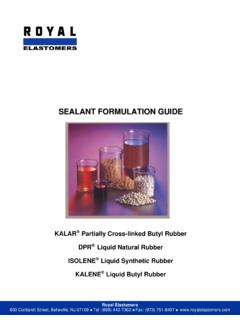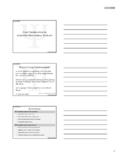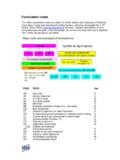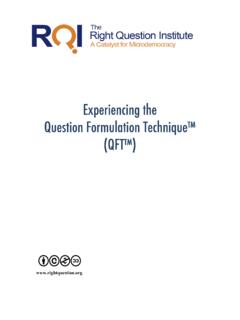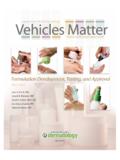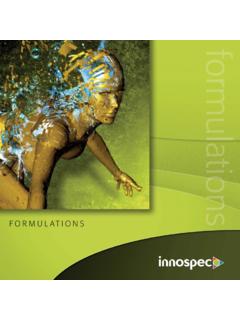Transcription of Extemporaneous formulations of Oral Liquids A …
1 Extemporaneous formulations of oral Liquids A guide David J Woods 1. Introduction Pharmacists and paediatricians are often faced with the problem of modifying an oral dose form intended for adult use into a suitable form for paediatric administration. Texts and research papers freely describe paediatric doses without exploring the logistics of dose administration. Tablets and capsules are generally unsuitable for administration to children aged under four years and a suitable tablet strength might not be available for use in older children. The range of commercially available paediatric oral Liquids and tablets is narrow because the relatively specialised use of these products makes industrial product development, manufacture and registration financially unattractive.
2 Availability varies between countries and very few products are available in countries which constitute a small market. There are, however, anomalies to this theory in that some oral Liquids (for example, captopril liquid , metronidazole suspension and rifampicin suspension) that are not available in North America are freely available in other countries such as New Zealand. In the absence of a ready-made product a frequent approach by pharmacists is to prepare an oral liquid from tablets, capsules or powdered drug dispersed or dissolved in a suitable base. These are often referred to as extemporaneously prepared formulations and the practice occurs on an international scale.
3 A survey of 210 pharmacists in the USA identified the eleven most frequently compounded preparations and the authors concluded that efforts by manufacturers and professional associations are required to supply pharmacists with information on the compounding and stability of Extemporaneous Stewart and 2. Tucker surveyed Australian hospitals and showed that 116 drugs were extemporaneously compounded into 270 different formulations for paediatric use. Frequent problems identified in this survey included disguising unpleasant taste, achieving dose uniformity and a lack of chemical and physical stability data.
4 This lack of stability information is a common problem and formularies of Extemporaneous formulations have been published in an attempt to provide some guidance on the preparation of paediatric oral Liquids . The first widely 3. available book was published in the UK in 1978 and is mainly a collation of individual hospitals' formulas and recommendations made by pharmaceutical companies with little reference to published data. This publication is now considered outdated and obsolete. Over the last 20 years researchers have studied the stability of many Extemporaneous formulations and these are summarised in three formularies which have been published in North ,5,6 However, the authors of these publications still describe a significant number of formulations which are not based on previously published data which indicates the requirement for further research.
5 Recently more comprehensive books have been published which give much more detail of published stability studies, physicochemical stability data on each drug and some discussion on alternative methods of preparing paediatric ,8. The formulation of an oral liquid for paediatric use requires careful consideration of many factors to ensure that the product is of optimum quality and efficacy. Compounding an oral liquid from crushed tablets should only be considered if there are adequate stability data and it should be recognised that there are often simpler or more reliable methods of preparing the dose.
6 Before discussing the formulation of oral Liquids it is important to briefly consider these alternatives some of which are perhaps under utilised. 2. Alternatives to formulation of oral Liquids (i) An alternative drug which is available commercially in liquid form could be selected. For example, it is usually preferable to use captopril oral solution rather than prepare enalapril solution from tablets. (ii) Tablet dispersion The practice of crushing tablets or opening capsules and adding the powder to a palatable drink or sprinkling onto solid food is a time-honoured alternative, but there are few circumstances when this method is appropriate or necessary.
7 It is difficult to ensure that a complete dose has been taken and the practice of nurses or carers handling powdered drug may present health Tablet dispersion is a simpler, more reliable and potentially safer ,10. If the tablet disperses in water, it can be dispersed in a small volume and the dose given when a suspension is formed, mixed with a flavoured vehicle if required. Not all tablets disperse readily but some form a suspension in If the tablet disperses readily and the drug is soluble, dispersing the tablet in a known volume of water allows a fractional dose to be accurately measured with a syringe as in the case of As extraction of soluble drug from the tablet excipients may be incomplete12,13.
8 The suspension should be shaken or stirred prior to measuring the dose and not filtered unless it has been established that active drug is not removed. In the case of an insoluble drug, the measurement of a fractional dose by taking an aliquot from a suspension formed in this way cannot be recommended due to probable rapid sedimentation of insoluble drug and resultant dosage inaccuracy. Tablet dispersion may not always be practical for infants when the doses required are the equivalent of small tablet fractions. (iii) oral administration of the injection This is possible for some drugs but there are important factors which must be considered when evaluating whether the injection is suitable for oral use.
9 This can be illustrated with some examples. (a) If the injectable form of the drug is the same as the oral form (for example labetalol hydrochloride, ondansetron hydrochloride) it can be assumed that the drug will be absorbed from the injectable formulation . However, as the drug is in solution more rapid absorption and higher peak levels may occur compared to slower absorption from a solid dose form. (b) Some injectable drug forms are produced by reaction of the insoluble oral form with sodium hydroxide to give a soluble salt (for example acetazolamide sodium, sodium folate).
10 In the acidic conditions of the stomach the oral form (acetazolamide, folic acid) will be generated. (c) The injectable form of drugs which are chemically degraded by gastric acid (for example omeprazole) are unsuitable for oral administration. (d) The oral use of the injectable form of a drug which is subjected to extensive first-pass metabolism, resulting in poor oral bioavailability, may be impractical due to the large volume required. For example, a volume of 15 mL (15 ampoules) of 1 mg per mL is required if propranolol injection is used to give an oral dose of 15 mg.
